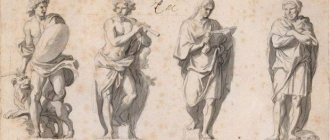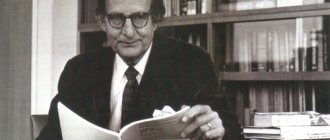What is temperament?
Temperament is a set of genetically determined mental qualities of a person, which depend on the characteristics of higher nervous activity. That is, this is an innate property of the psyche that a person cannot change . However, a person is able to successfully “disguise” or “smooth out” some qualities of his temperament. However, in stressful situations (including the effect of surprise), it is the innate quality that is more likely to manifest itself, rather than the acquired one.
By the way, not only people have temperament, but also some animals. These include dogs, cats, monkeys, horses, dolphins, etc. Human and animal temperament types are similar in many ways, but in humans they are more complex and deeper.
4 main types of temperament - choleric, sanguine, phlegmatic, melancholic. There is also a fifth temperament - ambivert, which includes people who do not have pronounced qualities of other temperaments, that is, they are always somewhere in the middle.
But now the main focus is the relationship between these properties in the individual’s psyche. In nature, there are no people with one type of temperament. All 4 types can coexist in the same person. However, 1-2 of them will be dominant. What does it mean?
For example, there is a person who is 50% sanguine, 30% melancholic, 15% phlegmatic and 5% choleric. This is a provisional calculation , since the exact percentage cannot be established. Obviously, the dominant type is sanguine, and in most life situations a person will behave according to the sanguine temperament. However, in some cases, a melancholic person may appear, which will temporarily and partially overshadow the dominant type. Phlegmatic and choleric people will also appear periodically, but rarely and for a short time. Our test will help you determine your propensity for a particular temperament.
But it is impossible to say exactly at what moment this or that psychotype decides to become active. There are several assumptions:
- one type of temperament is replaced by another when the first one cannot cope with the situation. For example, if something threatens the life of a phlegmatic person, he may suddenly discover a choleric person in himself;
- a change in activity occurs due to severe or prolonged stress. After her husband’s betrayal, a choleric woman withdraws into herself and allows her inner melancholic to emerge;
- different types are activated in different areas of life . For example, in work matters he is choleric, in relationships he is sanguine.
However, all these properties do not appear out of nowhere. If some type of temperament is not initially inherent in an individual, it will never appear. A person can pretend to be choleric/sanguine/phlegmatic/melancholic, but will never truly become one. That is, a melancholic person will be afraid to try new things, no matter how hard he tries to seem brave. And the phlegmatic person will continue to carry out work assignments slowly but thoughtfully, even if the deadline has already arrived and is looking at him menacingly.
Is it possible to change it
How to find a husband - where you can meet a worthy man for a family
The type of temperament is laid down in the child in the womb; on the other hand, each person, depending on the current situation, manifests himself differently. For example, under extreme conditions, even the most ardent melancholic person can become choleric for a while.
There is an opinion among people that temperament cannot be changed in any way. It is erroneous, since even the most ordinary person can change their temperament for a short time; trained people can, in principle, choose it for themselves. In the process of education and training, most people can easily work out all types of temperaments for themselves.
Temperament and character
These are different concepts. Temperament is biologically determined and unchangeable. Character can change throughout life, although it partly depends on the structure of the nervous system. A person himself is capable of influencing it. At the same time, formulating and consolidating or, conversely, eradicating a certain trait takes a lot of time and effort. Character is formed and changes as a result of:
- education received from parents,
- self-education,
- depth of cultural and ethical acceptance;
- self-development,
- gaining life experience.
It cannot be said that one factor significantly changes something in a person. The interaction of at least several conditions is required to trigger the suppression or acquisition of any trait. That is, a person may well live his whole life with the type of character that he developed in adolescence.
Temperament (T) does not “program” character (X) , but there is a mutual connection between these mental properties, which is expressed in the fact that:
- T determines the dynamics, degree, and method of expression of X. Both a choleric person and a melancholic person can be hardworking, but in each of them this property will manifest itself differently;
- T influences which traits of X are more likely to emerge and which are most likely not to emerge or not reach a high level of development;
- different types of T require individual approaches and different incentives for the formation of some trait X ;
- individual properties of X help control or even suppress for a long time the characteristics of innate T.
Example.
Temperament . In a phlegmatic person, mental processes proceed slowly. And in a choleric person, on the contrary, it’s fast.
Character . Both of these types, for example, acquired such qualities as responsibility, hard work and perseverance.
Situation . It is necessary to deliver an important project, on which the reputation of the company for which both specialists work depends.
Behavior . A phlegmatic person sits for hours on end at work and slowly but efficiently and consistently completes all tasks. He systematically adheres to some model that he considers most effective and useful for the company. The choleric person develops vigorous activity, makes a hundred decisions per hour, non-stop solves problems as they arise and improvises on the go.
It turns out that the same character traits manifest themselves differently due to different temperaments.
Jan Strelyau's technique
Jan Strelyau in his research proceeded from the typology of the nervous system of Pavlov, and was able to prove that the determination of the properties of the nervous system depends on the specific properties of the stimulus (degree of excitation and suppression, mobility and balance of nervous processes), and he created his own classification of temperaments
.
Based on the data from his test, Strelyau determined that the properties of the nervous system (Pavlova) can be used to describe such indicators of temperament as extroversion-introversion, neuroticism, and anxiety.
He created the concept of temperament - the regulatory theory of temperament
(RTT). Temperament (reactivity and activity) has an important role in regulating the relationship between people and the environment, and this is the meaning of RTT.
Strelyau believed that the properties of temperament “...arising on the basis of certain anatomical and physiological characteristics of the individual, are formed under the influence of upbringing and the social environment...” (Strelyau Ya. The role of temperament in mental development. M., 1982).
How to determine the type of temperament?
It is very useful to learn to calculate not only your own type (or types), but also the characteristics of those around you. Knowing your mental complex and its characteristics provides the following advantages :
- easier search for a suitable profession or hobby;
- establishing internal balance with your “I”;
- understanding your own strengths and weaknesses;
- awareness of the reasons why certain traits are very difficult to change;
- the ability to predict one’s behavior in unfamiliar situations;
- at the end of the day, it's just interesting and educational.
As for determining alien types, the advantages are as follows:
- understanding others and the ability to find an approach to people of different temperaments;
- improved relationships with relatives, friends, spouses and increased chances of a promising romantic acquaintance;
- the opportunity to realize your career by finding a common language with colleagues, superiors and clients;
- a more noticeable and successful influence on others (speaking and communication in general);
- predicting the standard behavior pattern of new acquaintances;
- a chance to get rid of addiction in relationships, victim status;
- a better understanding of how to raise your children.
The situation is reminiscent of a poker game. A person ignorant of his temperament does not understand the value of even his own cards. But those who study this topic will clearly see the entire layout of the game and easily calculate the opponent’s card combination.
To find out your type, just take a temperament test. If you need to understand another person, just watch him. Some properties will be clear immediately (how actively he gestures, for example), others will take more time.
Criteria for determining temperament
In modern psychology there is no single and universally accepted system for classifying these criteria. However, there are a few that are most popular. These include the theories of the ancient Greek physician Hippocrates and the ancient Roman physician Galen, the Russian physiologist Ivan Pavlov, and the British psychologist Hans Eysenck.
Hippocrates and Galen
In Ancient Greece and Rome, knowledge about psychology and its connection with biology, of course, was not nearly as developed as it is now. However, the theory of these scientists is worth considering. They first voiced 4 types of temperament and tried to give them a biological explanation.
Some doctors and philosophers of that time tried to develop a similar topic, but did not achieve significant success. And it was Hippocrates and Galen who systematized their knowledge and guesses, and then presented them in the form of a full-fledged theory. It was based on the idea of the predominance of a specific liquid in the body of each person - the “juice of life” (humo(u)r):
- choleric - yellow bile/poison (from the ancient Greek “chole”);
- sanguine - blood (from the ancient Greek “sangua”);
- phlegmatic - lymph/phlegm (from ancient Greek “phlegm”)
- melancholic - black bile (from the ancient Greek “melena chole”).
Each juice, according to doctors, forced a person to exhibit certain qualities. For a choleric person it is hysterical, for a sanguine person it is liveliness, for a phlegmatic person it is calm, and for a melancholic person it is sadness.
Ivan Pavlov
The scientist believed that the main criteria that determine the type of temperament are strength, mobility and balance .
Strength is the ability of an individual to be resilient, maintain performance even during intense and/or prolonged stress, and recover quickly. Types: strong (hardy) and weak (gets tired quickly).
Mobility is a feature of higher nervous activity, which is expressed in the individual’s ability to quickly switch between tasks, assimilate new information and respond to external stimuli. Types: mobile (reacts easily and quickly) and inert (reacts slowly).
Balance is a characteristic of an individual that allows him to control emotions, restrain sudden impulses and desires, and remain adequate. Types: balanced (calm) and unbalanced (emotionally expressive).
How these categories map to temperament is shown in the table.
| Temperament types | |||
| Weak | Melancholic | ||
| Strong | Choleric | Mobile, unbalanced | |
| Sanguine | Agile, balanced | ||
| Phlegmatic person | Inert, balanced | ||
Hans Eysenck
The English psychologist believed that the most important factors for determining the described mental property are the scale of introversion-extroversion, neuroticism and psychoticism .
Introversion-extroversion is the subject-object orientation of an individual, the direction of the main flow of his attention. Types: introversion (focus on internal mental processes) and extraversion (focus on the outside world).
Neuroticism is the degree to which an individual is emotionally balanced. Types: emotional stability (calmness, fixation) and lability (hysteria, neuroticism).
Psychotism is the degree to which an individual is predisposed to psychosis. Modern scientists deny the importance of this category in determining the psychotype. This is part of the psyche, but not the central one. In addition, the psychoticism scale is a very branched and ambiguous characteristic. Therefore, many new tests ignore it.
The table shows the relationship between these categories according to Eysenck's views.
| Categories | Introversion | Extraversion |
| Lability | Melancholic | Choleric |
| Stability | Phlegmatic person | Sanguine |
List of recommended literature
Batarshev A.V.
Temperament and properties of higher nervous activity [Text] / A.V. Batarshev. – M.: TC Sfera, 2002. – 88 p.
Mental states [Text]: reader / comp. L.V. Kulikov. – St. Petersburg: Peter, 2000. – 506 p.
Rusalov V.M.
Temperament [Text]: reference. management / V.M. Rusalov. – M.: Infra-M, 1999. – 687 p.
Examples of similar educational works
Analytical professional profile of the activities of a psychologist in the process of professional selection of candidates...
... activities. The psychological system of activity is a set of mental properties and qualities of the subject of labor, organized to perform the functions of a specific activity. The development of the psychological system of activity occurs both in the process...
Motivation of human activity 2
...society of behavior. Behavior is a socially significant part of the system of human activity. The formation of human behavior occurs through ways to satisfy human needs. In our work we intend to consider motivation...
Human cognitive activity 2
... The results can be used for future research. The object of the work is the system “Methodology and logic of human cognitive activity.” The subject of the study is the current relationship of the philosophical world to this problem. Target …
Human labor activity
... 2 - Characteristics of activity Main forms of activity: game; educational activities; work activity; leisure. The highest form of activity is labor. Labor is a fundamental form of human activity, in the process of which all...
Temperament should be understood as individually unique properties of the psyche that determine...
... chole - black bile). Characteristics of temperament types: Sanguine is a strong type of nervous system with a balanced ratio of excitation and inhibition processes. Such people have a mood “written all over their faces.” They give …
Types of temperament and their differences
Are common
Choleric . Hyperactive, hot-tempered, hasty, sociable, leader.
Sanguine . Active, cheerful, superficial, sociable, joker.
Phlegmatic . Calm, slow, thoughtful, closed, obsessive.
Melancholic . Vulnerable, creative, prone to empathy, emotional.
Body type
Choleric . Tall, thin build, long narrow flat chest. The forehead is wider than the lower part of the face, the chin is pointed. The nose is pointed, with a hump and a downward tip. Long neck, well defined cheekbones.
Sanguine . Round smooth shape, medium or low height, short wide bones. Wide short chest, round head and forehead, weakly defined cheekbones, short thick legs, neck.
Phlegmatic . Wide bones, massive build, short thick neck, wide short chest with a rounded shape. Large straight nose with a downturned tip. The chin is the same as the forehead, or wider.
Melancholic . Pointed features, fragile physique, thin bones, weak muscles, flat chest, long thin neck, high square forehead, the upper part of the face is noticeably wider than the lower.
Health
Choleric . The weak point is the digestive system (liver, gall bladder). Pulse - 75-85 beats per minute.
Sanguine . The weak point is the cardiovascular system. Pulse - 65-75 beats per minute.
Phlegmatic . The weak point is the digestive system (stomach, intestines). Pulse - less than 65 beats per minute.
Melancholic . The weak point is the nervous system. Pulse - more than 85 beats per minute.
Relationship
Choleric . He quickly gets along with people, often and quickly becomes emotionally attached, and is difficult to part with.
Sanguine . He quickly gets along with people, rarely gets attached, and easily replaces one person with another.
Phlegmatic . He gets along with people for a long time, rarely gets attached for a long time, and has a hard time letting people go from his life.
Melancholic . He gets along with people for a long time, often but slowly becomes attached, and is difficult to part with.
Career and performance
Choleric . Active, ambitious, persistent, creative. The boss, the leader, loves to lead. The priority is career growth.
Sanguine . Active, ambitious, superficial, excellent organizer. Leader, loves recognition. The priority is money.
Phlegmatic . Inert, slow, serious, reliable, driven. Likes to analyze and systematize. The priority is stability.
Melancholic . Inert, gets tired quickly, driven. Dreamer, thinker, creative person. The priority is a friendly, warm atmosphere.
Reaction to stress
Choleric . Angry, irritated, expresses emotions vividly. Calms down quickly. Goes to solve the problem.
Sanguine . Ignores the problem or finds advantages in it. Finds someone who can solve the problem or switches to another task.
Phlegmatic . Thinks about the causes of the problem. He thinks about the solution plan for a long time, then begins to systematically implement it.
Melancholic . He is lost, very worried, looking for support and help. If he doesn’t find it, he often gives up and worries about it for a long time.
Self-realization
Choleric . Demands popularity, because he loves when people depend on him. Goes ahead, takes risks and sacrifices.
Sanguine . He demands recognition because he loves to be admired. Obstacles are usually avoided.
Phlegmatic . Seeks to maintain the current state of affairs. Removes obstacles only if they interfere with his measured life, but does it effectively.
Melancholic . Needs recognition and emotional support to increase self-esteem. Often stops efforts because he is afraid that he will not cope.
Interests and hobbies
Choleric . Sports, extreme sports, travel, competitions, communication, quest games, excitement and risk.
Sanguine . Acting, humor, community service, communication, gossip, travel.
Phlegmatic . Puzzles, reading, crafts, cinema, science, nature, mechanics, architecture.
Melancholic . Art, puzzles, mysticism and esotericism, philosophy, meditation, handicrafts.
Knowing how different temperament types react to the world and life situations can be really helpful. Understanding yourself and others makes it easier and faster to achieve internal (personality) and external (relationship) harmony.











